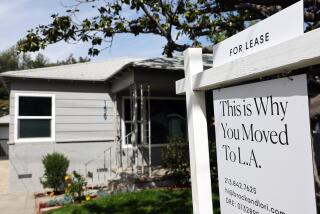A Growing Alternative for Seniors : Assisted Living Offers Home Away From Nursing Homes
COSTA MESA — Two years ago, Ken Corum and his wife, Melissa, a Mission Viejo couple in their 30s, were juggling two jobs, caring for their two tots and scurrying regularly to Long Beach to visit Ken’s feeble grandmother.
Unsuccessful back surgery had left Helen Corum frail, dependent on a wheelchair for getting around, and unable to live alone in her Long Beach home. The couple resolved the situation by moving her to a retirement home less than two miles from their residence.
“We visit once a week, sometimes more,” Melissa Corum says. “I can take her to the store or the doctor. She is close to her great-grandkids.
“It’s a tremendous burden off of us.”
Helen Corum, 81, now rents a room at Villa del Sol, a two-story Spanish-style building that resembles a small hotel and overlooks a golf course. It’s one of a growing number of facilities that several companies have built to accommodate senior citizens like Corum who need help with daily living but don’t require around-the-clock care provided by nursing homes.
Villa del Sol’s operator, Costa Mesa-based ARV Assisted Living Inc., is buying or building facilities like this across the country on the belief that rising numbers of the elderly will seek such accommodations as a lower-cost alternative to a nursing home.
“In five years, we anticipate having three times the number of facilities we have now,” says Gary L. Davidson, ARV’s chairman, who gained fame in the 1970s as a founder of several professional sports leagues. The company operates 37 facilities, mostly in California, and has 13 more under development around the country.
ARV is one of several companies that have gone public in the last 18 months to finance expansions plans in the “assisted living” market, but some major corporations also are in the field. Hospitality and food service giant Marriott International Inc., for example, recently expanded its assisted living operations by investing $600 million to buy the Forum Group, which operates a nationwide chain of these facilities and other retirement centers for seniors.
Marriott’s ambitious expansion in the area can be traced largely to demographics. “The number of people over age 85 is expected to grow 42% by the year 2005,” says Paul Johnson, executive vice president of the company’s senior living services division.
But there are risks. Mark Banta, an analyst at Salomon Brothers, notes that while demographic trends are fueling the industry’s growth, “there is the potential for overbuilding.”
Although the flurry of stock offerings, favorable analysts’ reports and demographics on the graying of America recently have whipped up enthusiasm for Wall Street investments in assisted living outfits, none of the newly public companies is making much money, if any. The problem, note analysts, is that it takes a while before newly developed facilities become occupied and cash flow turns positive.
ARV, for example, is expected to post its first quarterly profit--about $300,000--on revenue of about $11.5 million in the three-month period ended March 31.
*
There’s also the possibility that the industry’s rapid expansion may spur government regulators to step up their scrutiny of the industry. Elizabeth Clemmer, manager of consumer policy research at the American Assn. of Retired Persons, notes that state regulators and consumer advocates are concerned about quality of care as the industry expands.
“This is an industry that’s full of entrepreneurs, full of developers, many of whom have shareholders [to satisfy],” she says. She questions whether their facilities “will remain good places to live when they have to focus on what the shareholder wants.”
ARV periodically has been cited by the Department of Social Services, which inspects residential facilities for senior citizens.
Last year, ARV’s Villa del Obispo in San Juan Capistrano paid a $150 penalty for failing to supervise residents who tend to wander. An inspector reported that the facility called the Sheriff’s Department several times to report that residents had wandered off.
ARV’s Acacia Villa, in Fullerton, was cited for having a resident with a medical problem that required more care than the facility’s license allows.
ARV officials say the company took immediate steps to respond to inspectors’ concerns, and that all of the company’s facilities are licensed. They also note that ARV can make money enough to satisfy investors only if it can maintain quality accommodations and high occupancy levels.
Various operators define the concept of assisted living differently, though it generally entails a variety of services offered to seniors, depending on need.
*
ARV charges an average of about $1,500 a month for basic services, which include room rental, maid service, three meals a day, use of common areas, transportation and staff-run activities, such as book clubs, bingo games and parties.
Additional services, which can add up to $1,000 more a month, range from assistance with medications, bathing, dressing, using the toilet and getting to the common dining area, to intensive care for those with incontinence or other problems that require around-the-clock help.
The Corum family exemplifies ARV’s target market. While younger women like Melissa Corum often cared for aging relatives at home in the past, analysts say that rising numbers of women are in the work force and have no time for that now.
During a recent interview at Villa del Sol, Helen Corum rolled her wheelchair from her room onto her private patio overlooking the golf course below.
“Here’s where I spend probably three-fourths of my time,” she says. “I sit out here and read my newspaper and work my crossword puzzles and watch the birds and water my flowers--a big job for someone in a wheelchair.”
Corum has undergone physical therapy and can walk short distances now, but she still needs help getting around. A resident drops by to escort her to lunch on the first floor.
“The only complaint I have is the food,” Corum says. “I haven’t eaten any vegetables since I got here because they’re cooked too much for me.” (That same day, resident Dolly Walker, 94, had confided that the vegetables actually are undercooked.)
*
Complaints about the food aren’t new to Davidson, ARV’s chairman. He recalled how his own mother, now deceased, would call him daily from Villa del Sol to report that her toast hadn’t been buttered the way she liked, that the peas on her plate had been placed too close to the corn.
He admits it’s not easy to run these facilities. “The job involves attention to details. You’re dealing with a very, very finicky clientele who have a lot of time on their hands.”
Davidson, an attorney, had founded the former American Basketball and World Hockey associations and the World Football League before turning his attention to senior housing investments in the late 1970s.
When John Booty, an acquaintance from the Balboa Bay Club, approached Davidson with a proposal to help finance a retirement home in Placentia, Davidson suggested they develop a chain of facilities.
They founded ARV. By the time the company went public last year, it was operating 31 assisted-living facilities, with more than 3,500 units, in 10 states, including California.
Still, the company found that it had to tighten up its accounting procedures to satisfy Wall Street.
On accountants’ advice, the company quit booking revenue for management fees that ARV received for partially completed construction projects. The company began recording revenue only after facilities had opened and achieved stable occupancy levels, among other things.
As word of the accounting change spread, analysts lowered their estimates of company revenue for the quarter ended last September. The stock then took a beating, falling from $15.25 on Oct. 26 to $10 a month later. The stock now has recouped those losses, and then some. It closed Thursday at $19.75 per share on the Nasdaq market.
*
ARV is moving ahead with plans to add more than a dozen new facilities, but managing existing facilities presents plenty of challenges.
Villa del Sol’s occupancy dropped 5 percentage points to 90% after the winter holidays when the industry often experiences an uptick in deaths. Constant efforts by the Mission Viejo facility’s marketing manager to keep local physicians, hospitals and referring agencies aware of its presence in the community evidently paid off. Occupancy has since crept back up to 95%, two points above the companywide average goal.
(BEGIN TEXT OF INFOBOX / INFOGRAPHIC)
America’s Aging Population
The demand for senior care facilities is expected to increase as the elderly make up a larger proportion of the total population. Yearly totals in millions:
*--*
Age 1994 % of total population 2000* % of total population 70-74 8.7 26.4% 9.0 25.4% 75-79 6.6 19.8 7.5 21.3 80-84 4.4 13.1 4.9 14.0 85 and older 3.5 10.6 4.3 12.3
*--*
* Projection
ARV Assisted Living at a Glance
* Headquarters: Costa Mesa
* Business: Senior residential facilities
* Chairman: Gary L. Davidson
* Employees: 1,375
* Facilities: 37, with plans to add 13
Senior Care Options
Living arrangements for the elderly now include a variety of options besides institutional nursing home care. Most are based on the level of medical and physical assistance required.
Senior apartments: Must be able to function independently. No medical or household assistance provided. $300 to $1,500 per month.
Assisted-living facilities: Similar to senior apartments, but meals and transportation are provided. Some also provide daily living assistance at a higher monthly cost. $500 to $4,000 per month.
Board and care homes: State-licensed homes in neighborhood settings. Provides meals and assistance with daily living. $1,000 to $3,500 per month.
Alzheimer’s or dementia care: Intermediate care in a home or facility setting. Meals, daily living assistance and 24-hour nurse. Premises gated and secured to prevent wandering. $2,000 to $4,000 per month.
Skilled nursing facilities: 24-hour nursing care in hospital-like setting. Patients usually share rooms and eat in a cafeteria. Many use a wheelchair or are bedridden and require skilled nursing care. $3,000 to $6,000 per month.
Source: U.S. ElderCare Referral Agency; Researched by JANICE L. JONES / Los Angeles Times
More to Read
Sign up for Essential California
The most important California stories and recommendations in your inbox every morning.
You may occasionally receive promotional content from the Los Angeles Times.










